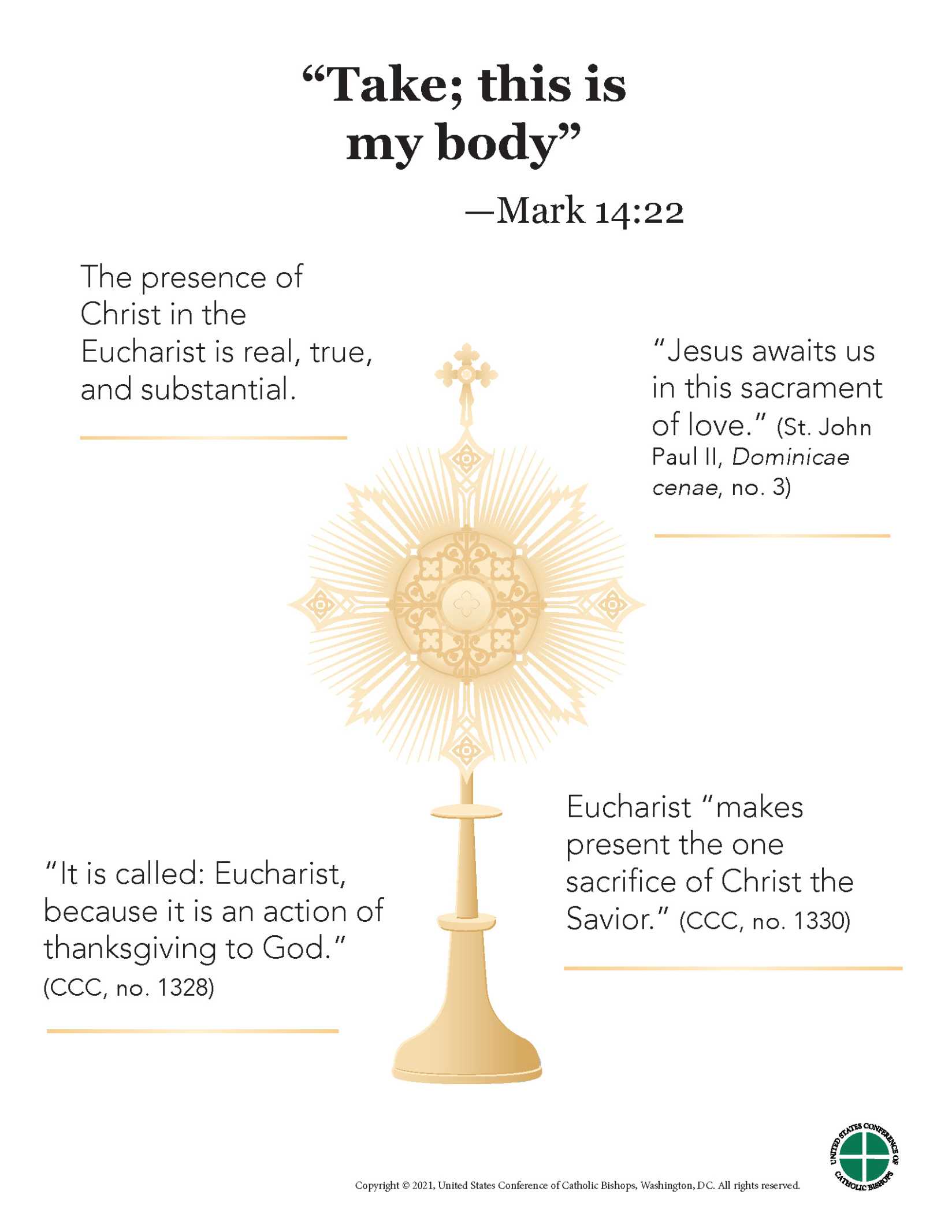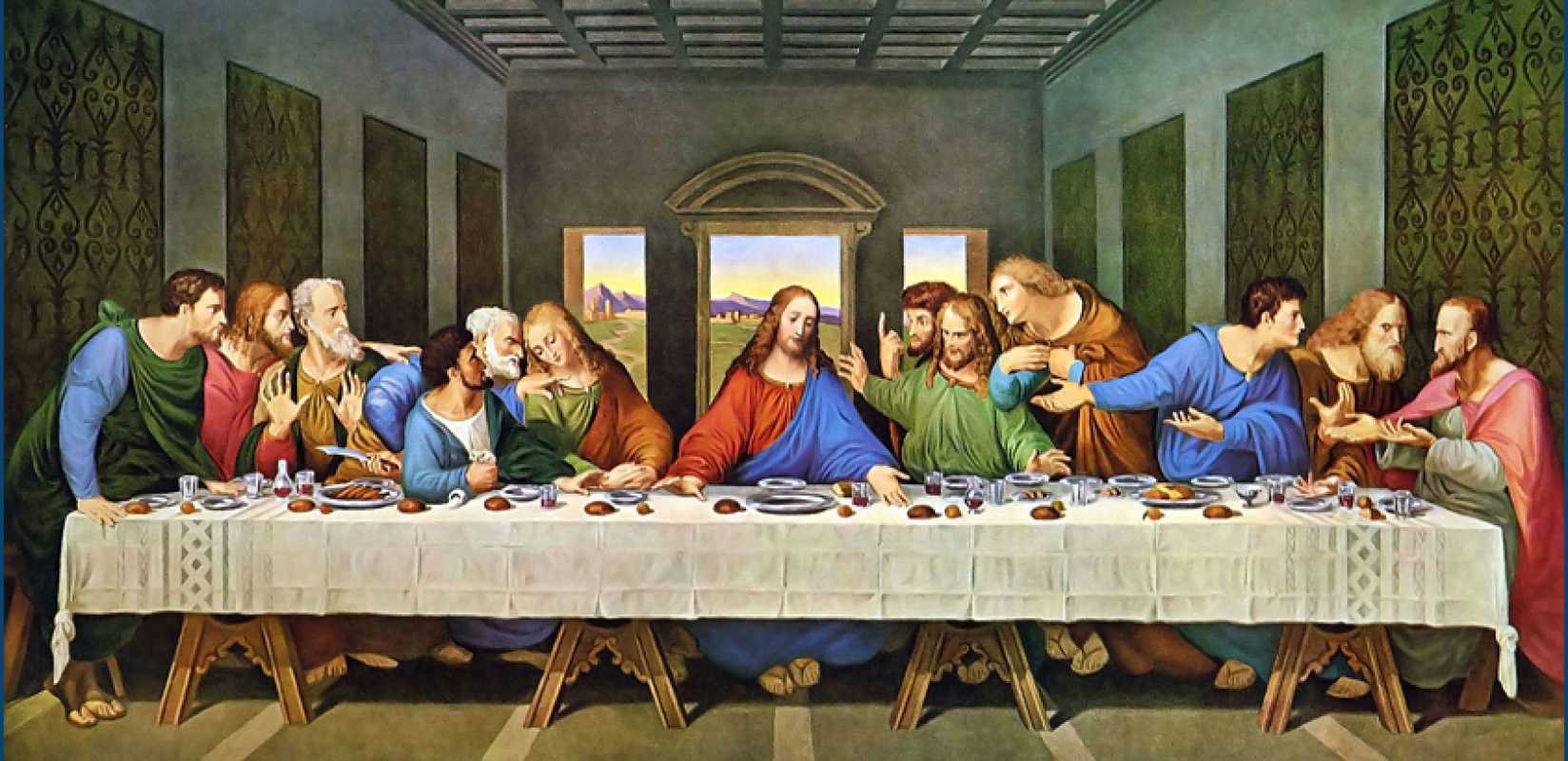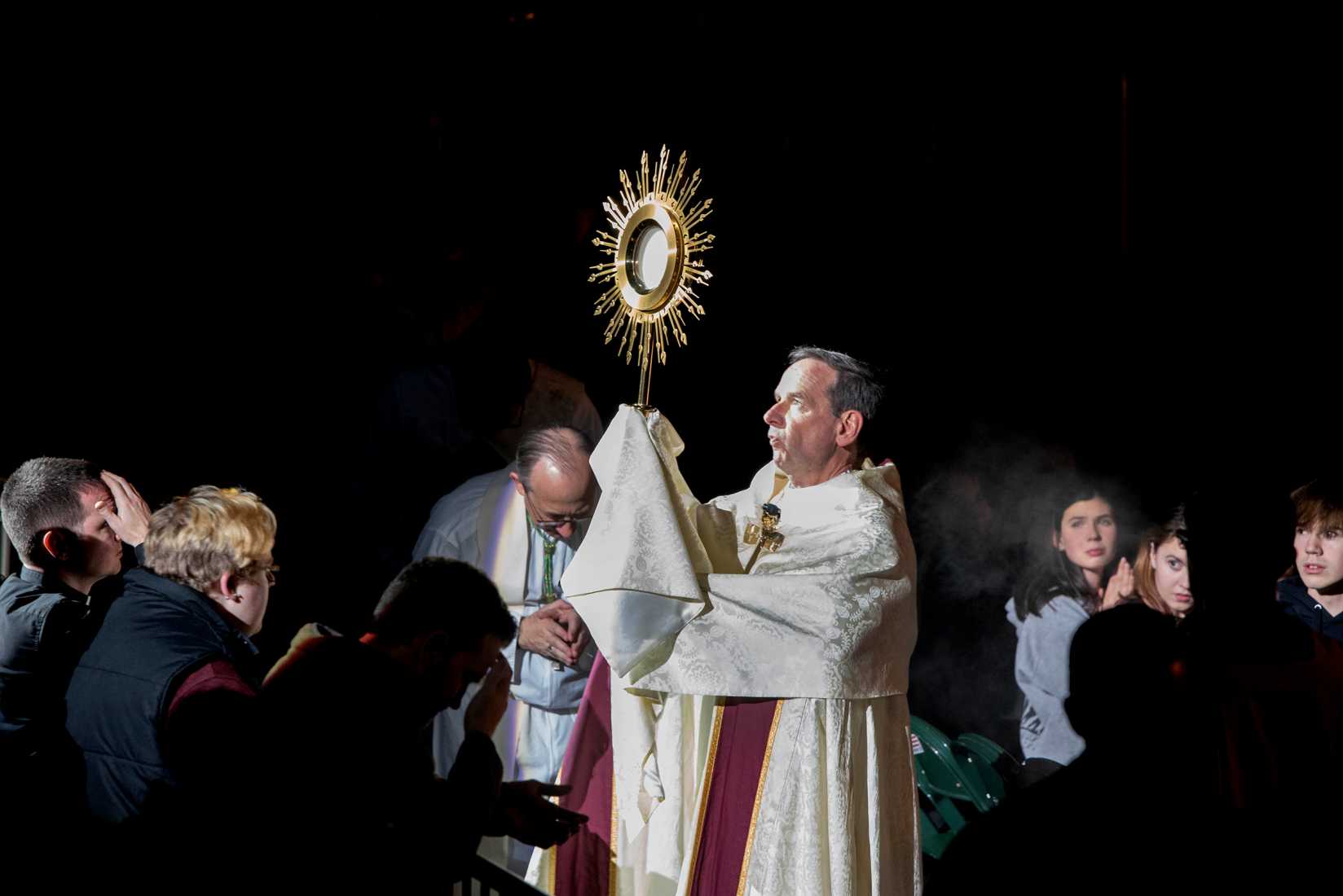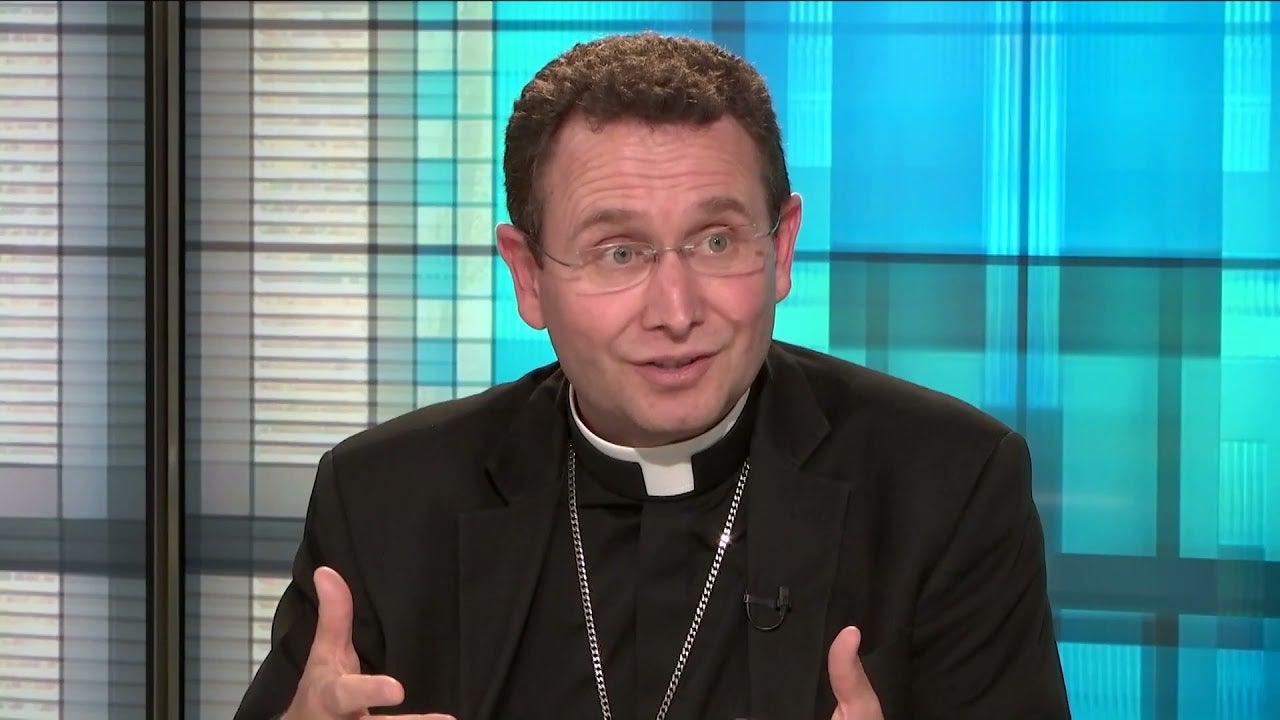The Eucharist
What is the Eucharist?
The Eucharist is the source and summit of the Christian life. The term “Eucharist” originates from the Greek word eucharistia, meaning thanksgiving.

In the celebration of the Eucharist, bread and wine become the Body and Blood of Jesus Christ through the power of the Holy Spirit and the instrumentality of the priest. The whole Christ is truly present -- body, blood, soul, and divinity -- under the appearances of bread and wine, the glorified Christ who rose from the dead. This is what the Church means when she speaks of the "Real Presence" of Christ in the Eucharist.
Where is the Eucharist mentioned in the Bible?
The Lord Jesus, on the night before he suffered on the cross, shared one last meal with his disciples. During this meal our Savior instituted the sacrament of his Body and Blood. He did this in order to perpetuate the sacrifice of the Cross throughout the ages and to entrust to the Church a memorial of his death and resurrection. The Institution of the Eucharist is written down in the four Gospels below:

Why does Jesus give himself to us as food and drink?
Jesus gives himself to us in the Eucharist as spiritual nourishment because he loves us. By eating the Body and drinking the Blood of Christ in the Eucharist, we become united to the person of Christ through his humanity. "Whoever eats my flesh and drinks my blood remains in me and I in him" (Jn 6:56). In being united to the humanity of Christ, we are at the same time united to his divinity. Our mortal and corruptible natures are transformed by being joined to the source of life.
Is the Eucharist a symbol?
The transformed bread and wine are truly the Body and Blood of Christ and are not merely symbols. When Christ said “This is my body” and “This is my blood,” the bread and wine are transubstantiated. Though the bread and wine appear the same to our human faculties, they are actually the real body and blood of Jesus.
The Liturgy of the Eucharist
The Liturgy of the Eucharist begins with the preparation of the gifts and the altar. As the ministers prepare the altar, representatives of the people bring forward the bread and wine that will become the Body and Blood of Christ. The celebrant blesses and praises God for these gifts and places them on the altar, the place of the Eucharistic sacrifice. In addition to the bread and wine, monetary gifts for the support of the Church and the care of the poor may be brought forward. The Prayer over the Offerings concludes this preparation and disposes all for the Eucharistic Prayer.
The Eucharistic Prayer
The Eucharistic Prayer is the heart of the Liturgy of the Eucharist. In this prayer, the celebrant acts in the person of Christ as head of his body, the Church. He gathers not only the bread and the wine, but the substance of our lives and joins them to Christ's perfect sacrifice, offering them to the Father.
The introductory dialogue establishes that this prayer is the prayer of the baptized and ordained, is offered in the presence of God, and has thanksgiving as its central focus. Following this dialogue, the celebrant begins the Preface, which consists of four different Eucharistic Prayers. After these prayers, communion is then given.
The following timeline follows the traditional Liturgy of the Eucharist:
- Presentation of the Gifts and Preparation of the Altar
- Prayer over the Offering
- Eucharistic Prayer
- Preface
- Holy, Holy, Holy
- First half of prayer, including Consecration
- Mystery of Faith
- Second half of prayer, ending with Doxology
- The Lord's Prayer
- Sign of Peace
- Lamb of God
- Communion
- Prayer after Communion
The document The Mystery of the Eucharist in the Life of the Church was developed by the Committee on Doctrine of the United States Conference of Catholic Bishops (USCCB). It was approved by the full body of the USCCB at its November 2021 General Meeting and has been authorized for publication.

Catholic News Service Communion Podcast
Conclusion
By his Real Presence in the Eucharist Christ fulfils his promise to be with us "always, until the end of the age" (Mt 28:20). As St. Thomas Aquinas wrote, "It is the law of friendship that friends should live together. . . . Christ has not left us without his bodily presence in this our pilgrimage, but he joins us to himself in this sacrament in the reality of his body and blood" ( Summa Theologiae, III q. 75, a. 1). With this gift of Christ's presence in our midst, the Church is truly blessed. As Jesus told his disciples, referring to his presence among them, "Amen, I say to you, many prophets and righteous people longed to see what you see but did not see it, and to hear what you hear but did not hear it" (Mt 13:17). In the Eucharist the Church both receives the gift of Jesus Christ and gives grateful thanks to God for such a blessing. This thanksgiving is the only proper response, for through this gift of himself in the celebration of the Eucharist under the appearances of bread and wine Christ gives us the gift of eternal life.
Amen, amen, I say to you, unless you eat the flesh of the Son of Man and drink his blood, you do not have life within you. Whoever eats my flesh and drinks my blood has eternal life, and I will raise him on the last day. For my flesh is true food, and my blood is true drink. . . . Just as the living Father sent me and I have life because of the Father, so also the one who feeds on me will have life because of me. (Jn 6:53-57)
For Further Reading
- Congregation for the Eastern Churches, Instruction on Liturgy (January 1996).
- Congregation of Rites, Eucharisticum Mysterium, Instruction on the Worship of the Eucharist (May 25, 1967).
- Pope John Paul II, Dominicae Cenae, Letter to the Bishops of the Church on the Mystery and Worship of the Eucharist (February 24, 1980).
- Pope Paul VI, Mysterium Fidei, Encyclical on the Holy Eucharist (September 3, 1965).
- Pope Pius XII, Mediator Dei, Encyclical on the Sacred Liturgy (November 20, 1947).
- Second Vatican Council, Sacrosanctum Concilium, Constitution on the Sacred Liturgy (December 4, 1963).
- Subcommittee on the Third Millennium, National Conference of Catholic Bishops, A Book of Readings on the Eucharist: A Eucharistic Jubilee (Washington, D.C.: United States Catholic Conference, 2000).
- Theological-Historical Commission for the Great Jubilee of the Year 2000, The Eucharist, Gift of Divine Life (New York: The Crossroad Publishing Company, 1999).
Other Typically Asked Questions Regarding the Eucharist
Why does Jesus give himself to us as food and drink?
Jesus gives himself to us in the Eucharist as spiritual nourishment because he loves us. God's whole plan for our salvation is directed to our participation in the life of the Trinity, the communion of Father, Son, and Holy Spirit. Our sharing in this life begins with our Baptism, when by the power of the Holy Spirit we are joined to Christ, thus becoming adopted sons and daughters of the Father. It is strengthened and increased in Confirmation. It is nourished and deepened through our participation in the Eucharist. By eating the Body and drinking the Blood of Christ in the Eucharist, we become united to the person of Christ through his humanity. "Whoever eats my flesh and drinks my blood remains in me and I in him" (Jn 6:56). In being united to the humanity of Christ, we are at the same time united to his divinity. Our mortal and corruptible natures are transformed by being joined to the source of life. "Just as the living Father sent me and I have life because of the Father, so also the one who feeds on me will have life because of me" (Jn 6:57). By being united to Christ through the power of the Holy Spirit dwelling in us, we are drawn up into the eternal relationship of love among the Father, the Son, and the Holy Spirit. As Jesus is the eternal Son of God by nature, so we become sons and daughters of God by adoption through the sacrament of Baptism. Through the sacraments of Baptism and Confirmation (Chrismation), we are temples of the Holy Spirit, who dwells in us, and by his indwelling we are made holy by the gift of sanctifying grace. The ultimate promise of the Gospel is that we will share in the life of the Holy Trinity. The Fathers of the Church called this participation in the divine life "divinization" ( theosis). In this we see that God does not merely send us good things from on high; instead, we are brought up into the inner life of God, the communion among the Father, the Son, and the Holy Spirit. In the celebration of the Eucharist (which means "thanksgiving") we give praise and glory to God for this sublime gift.
Why is the Eucharist not only a meal but also a sacrifice?
While our sins would have made it impossible for us to share in the life of God, Jesus Christ was sent to remove this obstacle. His death was a sacrifice for our sins. Christ is "the Lamb of God, who takes away the sin of the world" (Jn 1:29). Through his death and resurrection, he conquered sin and death and reconciled us to God. The Eucharist is the memorial of this sacrifice. The Church gathers to remember and to represent the sacrifice of Christ in which we share through the action of the priest and the power of the Holy Spirit. Through the celebration of the Eucharist, we are joined to Christ's sacrifice and receive its inexhaustible benefits.
When the bread and wine become the Body and Blood of Christ, why do they still look and taste like bread and wine?
In the celebration of the Eucharist, the glorified Christ becomes present under the appearances of bread and wine in a way that is unique, a way that is uniquely suited to the Eucharist. In the Church's traditional theological language, in the act of consecration during the Eucharist the "substance" of the bread and wine is changed by the power of the Holy Spirit into the "substance" of the Body and Blood of Jesus Christ. At the same time, the "accidents" or appearances of bread and wine remain. "Substance" and "accident" are here used as philosophical terms that have been adapted by great medieval theologians such as St. Thomas Aquinas in their efforts to understand and explain the faith. Such terms are used to convey the fact that what appears to be bread and wine in every way (at the level of "accidents" or physical attributes - that is, what can be seen, touched, tasted, or measured) in fact is now the Body and Blood of Christ (at the level of "substance" or deepest reality). This change at the level of substance from bread and wine into the Body and Blood of Christ is called "transubstantiation." According to Catholic faith, we can speak of the Real Presence of Christ in the Eucharist because this transubstantiation has occurred (cf. Catechism, no. 1376).
Does the bread cease to be bread and the wine cease to be wine?
Yes. In order for the whole Christ to be present—body, blood, soul, and divinity—the bread and wine cannot remain, but must give way so that his glorified Body and Blood may be present. Thus in the Eucharist the bread ceases to be bread in substance, and becomes the Body of Christ, while the wine ceases to be wine in substance, and becomes the Blood of Christ. As St. Thomas Aquinas observed, Christ is not quoted as saying, " This bread is my body," but " This is my body" ( Summa Theologiae, III q. 78, a. 5).
Is it fitting that Christ's Body and Blood become present in the Eucharist under the appearances of bread and wine?
Yes, for this way of being present corresponds perfectly to the sacramental celebration of the Eucharist. Jesus Christ gives himself to us in a form that employs the symbolism inherent in eating bread and drinking wine. Furthermore, being present under the appearances of bread and wine, Christ gives himself to us in a form that is appropriate for human eating and drinking. Also, this kind of presence corresponds to the virtue of faith, for the presence of the Body and Blood of Christ cannot be detected or discerned by any way other than faith. That is why St. Bonaventure affirmed: "There is no difficulty over Christ's being present in the sacrament as in a sign; the great difficulty is in the fact that He is really in the sacrament, as He is in heaven. And so believing this is especially meritorious" ( In IV Sent., dist. X, P. I, art. un., qu. I). On the authority of God who reveals himself to us, by faith we believe that which cannot be grasped by our human faculties (cf. Catechism, no. 1381).
Are the consecrated bread and wine "merely symbols"?
In everyday language, we call a "symbol" something that points beyond itself to something else, often to several other realities at once. The transformed bread and wine that are the Body and Blood of Christ are not merely symbols because they truly are the Body and Blood of Christ. As St. John Damascene wrote: "The bread and wine are not a foreshadowing of the body and blood of Christ—By no means!—but the actual deified body of the Lord, because the Lord Himself said: ‘This is my body'; not ‘a foreshadowing of my body' but ‘my body,' and not ‘a foreshadowing of my blood' but ‘my blood'" ( The Orthodox Faith, IV [PG 94, 1148-49]). At the same time, however, it is important to recognize that the Body and Blood of Christ come to us in the Eucharist in a sacramental form. In other words, Christ is present under the appearances of bread and wine, not in his own proper form. We cannot presume to know all the reasons behind God's actions. God uses, however, the symbolism inherent in the eating of bread and the drinking of wine at the natural level to illuminate the meaning of what is being accomplished in the Eucharist through Jesus Christ.
Do the consecrated bread and wine cease to be the Body and Blood of Christ when the Mass is over?
No. During the celebration of the Eucharist, the bread and wine become the Body and Blood of Christ, and this they remain. They cannot turn back into bread and wine, for they are no longer bread and wine at all. There is thus no reason for them to change back to their "normal" state after the special circumstances of the Mass are past.
Why are some of the consecrated hosts reserved after the Mass?
While it would be possible to eat all of the bread that is consecrated during the Mass, some is usually kept in the tabernacle. The Body of Christ under the appearance of bread that is kept or "reserved" after the Mass is commonly referred to as the "Blessed Sacrament." There are several pastoral reasons for reserving the Blessed Sacrament. First of all, it is used for distribution to the dying (Viaticum), the sick, and those who legitimately cannot be present for the celebration of the Eucharist. Secondly, the Body of Christ in the form of bread is to be adored when it is exposed, as in the Rite of Eucharistic Exposition and Benediction, when it is carried in eucharistic processions, or when it is simply placed in the tabernacle, before which people pray privately.
What are appropriate signs of reverence with respect to the Body and Blood of Christ?
The Body and Blood of Christ present under the appearances of bread and wine are treated with the greatest reverence both during and after the celebration of the Eucharist (cf. Mysterium Fidei, nos. 56-61). For example, the tabernacle in which the consecrated bread is reserved is placed "in some part of the church or oratory which is distinguished, conspicuous, beautifully decorated, and suitable for prayer" ( Code of Canon Law, Can. 938, §2). According to the tradition of the Latin Church, one should genuflect in the presence of the tabernacle containing the reserved sacrament. In the Eastern Catholic Churches, the traditional practice is to make the sign of the cross and to bow profoundly. The liturgical gestures from both traditions reflect reverence, respect, and adoration. It is appropriate for the members of the assembly to greet each other in the gathering space of the church (that is, the vestibule or narthex), but it is not appropriate to speak in loud or boisterous tones in the body of the church (that is, the nave) because of the presence of Christ in the tabernacle. Also, the Church requires everyone to fast before receiving the Body and Blood of Christ as a sign of reverence and recollection (unless illness prevents one from doing so). In the Latin Church, one must generally fast for at least one hour; members of Eastern Catholic Churches must follow the practice established by their own Church.
Why do we call the presence of Christ in the Eucharist a "mystery"?
The word "mystery" is commonly used to refer to something that escapes the full comprehension of the human mind. In the Bible, however, the word has a deeper and more specific meaning, for it refers to aspects of God's plan of salvation for humanity, which has already begun but will be completed only with the end of time.
The Eucharist is a mystery because it participates in the mystery of Jesus Christ and God's plan to save humanity through Christ. We should not be surprised if there are aspects of the Eucharist that are not easy to understand, for God's plan for the world has repeatedly surpassed human expectations and human understanding. Furthermore, any time that we are speaking of God we need to keep in mind that our human concepts never entirely grasp God. We must not try to limit God to our understanding, but allow our understanding to be stretched beyond its normal limitations by God's revelation.
Holy Communion vs Eucharist FAQ
The word "Eucharist" refers to the Sacrament of the Eucharist, which is the Body and Blood of Jesus Christ truly present on the altar under the appearances of bread and wine. The word "communion" refers the actual reception of the Eucharist by the person receiving it, as well as the communion of the members of the Church.

